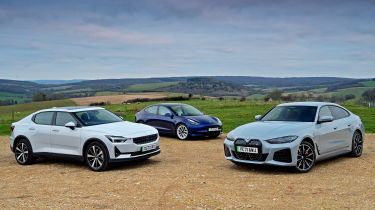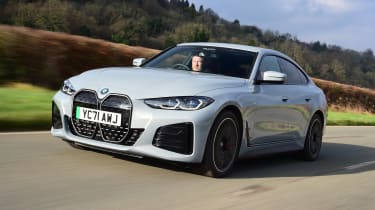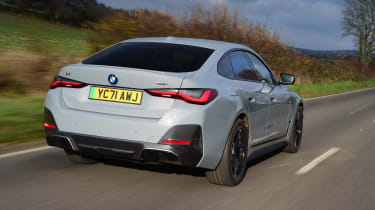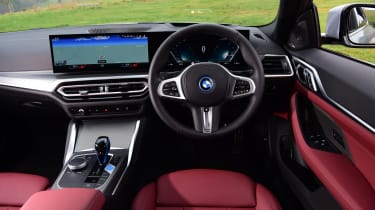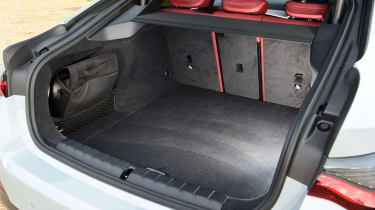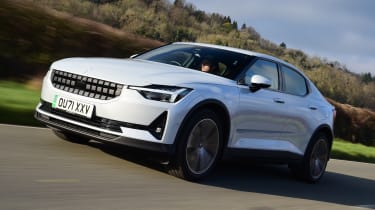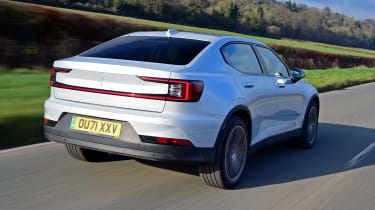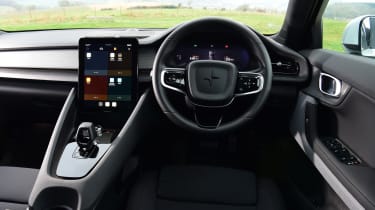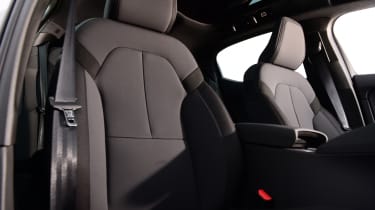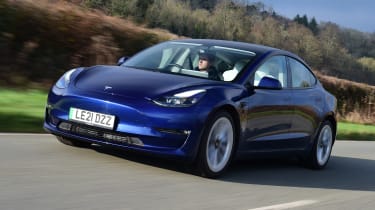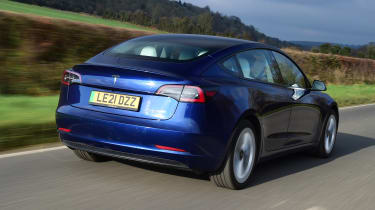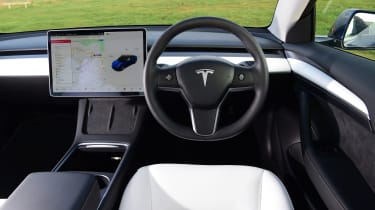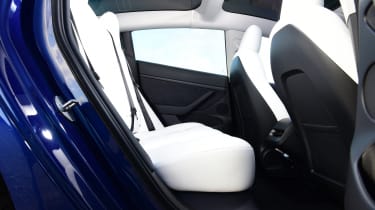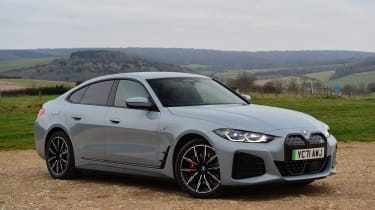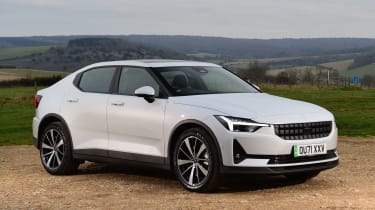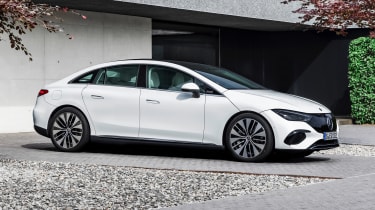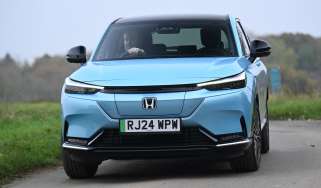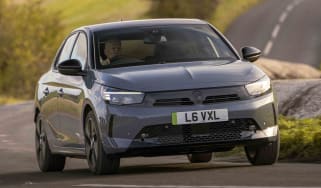BMW i4 vs Polestar 2 vs Tesla Model 3: 2022 group test review
BMW's new i4 goes up against the Tesla Model 3 and Polestar 2 in this all-electric executive battle
Range anxiety. Two words that have probably held back many potential electric car buyers from making the switch. But progress continues at a staggering pace, with new tech bringing faster charging rates, more efficient motors and better batteries, so the bottom line is that those two words are becoming increasingly irrelevant.
Here we line up three long-rangers; electric cars that can cover more ground on a full charge than most
drivers would feel comfortable doing in a stint behind the wheel. The BMW i4 is the latest model in the firm’s electric onslaught. It certainly offers some very promising numbers on paper, but in this company, it needs to.
The next challenger is the handsome Polestar 2. We have the latest Long Range Single Motor version here, which can go further between charges than any variant before it.
Then there’s the Tesla Model 3. Range has never been an issue with the US brand’s line-up, so we’re keen to find out whether it can still show its rivals the way.
BMW i4
| Model: | BMW i4 eDrive40 M Sport |
| Price: | £53,405 |
| Engine: | Single motor, 80.7kWh battery, 335bhp |
| 0-62mph: | 5.7 seconds |
| Test economy: | 3.8mi/kWh |
| Test range: | 307 miles |
| Annual road tax: | £0 |
The BMW i4 in eDrive40 M Sport trim driven here costs £53,405. Add the Visibility Pack (£1,500, including laser headlights), Tech Plus Pack (£3,900, with steering-assisted cruise control, a Harman Kardon sound system and more), M Sport Pro pack (£2,500, with 19-inch wheels, uprated brakes and variable steering) plus the Brooklyn Grey paint paired with fetching Red leather upholstery (£695 and £1,300 respectively) and the total climbs to £63,200.
Used - available now
Design & engineering
If you think that the i4 looks a little familiar, that’s because its bodyshell is very similar to the combustion-powered 4 Series Gran Coupé’s. However, there are some subtle differences, chief among them being the grille. Here it’s almost completely faired in, save for subtle flaps at the lower edge that open when cooling is required, and shut in order to reduce drag and maximise range.
Inside, it will be familiar to 3 and 4 Series owners, too, which means flawless build quality (the BMW pips the Polestar and easily beats the Tesla in this area) and a great driving position. The pair of huge digital displays are an obvious i4-specific feature, which we’ll cover in the infotainment section.
The i4 is fitted with BMW’s latest-generation electric motor, a unit which is claimed to offer a 30 per cent increase in power density when compared with BMW’s first production EV, the i3 city car. This i4 eDrive40 is powered by a single electric motor, which drives the back wheels. In total, it makes 335bhp and 430Nm – less than the dual-motor Tesla, but more than the Polestar. Above the 40 in the i4 range sits the M50. This adds a second electric motor at the front for a total of 469bhp and 730Nm. A 10-second boost mode bumps those numbers to the full 537bhp and 795Nm, and enables the i4 to cover the 0-62mph sprint in 3.9 seconds.
The installation of an electric powertrain makes some pretty fundamental changes to the i4’s mass and weight distribution when compared with its ICE cousins. Yes, the weight of the lithium-ion battery, which has an 80.7kWh usable capacity, means the car tips the scales at 2,125kg, but BMW says that its position low in the car’s floor means the overall centre of gravity is 53mm lower than a 3 Series saloon’s. One stand-out feature of the i4 is that air suspension is fitted as standard at the rear, to help the chassis retain its composure when the car is loaded up.
Driving
You only need to drive the BMW i4 a few yards to establish one thing; it’s comfortably the best EV in this test for the keen driver, and one of the best at any price. Indeed, if it wasn’t for the eerie silence of the electric powertrain, you’d be hard pushed to tell the i4 apart from any combustion-powered 4 Series Gran Coupé – despite that extra weight on board.
The i4 turns into corners keenly, without any hint of understeer. The steering is precise and has the most natural weighting of this trio. There’s just enough body roll to let the driver know how much grip there is; that’s plenty, usually, unless you get too enthusiastic on the throttle. With 430Nm of torque being deployed through the rear wheels, there’s a gentle and progressive amount of slip. The i4 proves that ditching a combustion engine doesn’t mean ditching the feel and driving enjoyment that’s expected from a BMW.
Yet despite this, the i4 is also the most comfortable car here, again by quite a margin. Leave the dampers in comfort mode, and the car rides without any of the jarring harshness or fidget that is present in the other two. Whether in town or on long journeys, it’s the most relaxing option here.
Practicality
Pop the BMW’s bonnet, and there’s not much to see – only a huge plastic panel that covers much of the car’s electronics. In contrast, both of its rivals have storage areas under theirs. Despite this, the BMW’s overall load volume of 470 litres is still larger than the figures quoted for the other two cars, which are the capacities of the front and rear cargo areas combined.
One of the benefits of using the 4 Series Gran Coupé’s body as a starting point is that the i4 benefits from a practical hatchback tailgate, so the boot is much more accessible than the Model 3’s. The rear seats fold down, too, creating a total capacity of 1,290 litres.
It’s not all good news, though. There’s quite a large central hump and a narrow middle seat in the rear, so the i4 isn’t great for carrying three passengers in the back. Two adults will sit happily there, though.
Ownership
In our 2021 Driver Power satisfaction survey, BMW finished a lowly 21st out of 29 brands in the overall manufacturer rankings. That’s in stark contrast to Tesla, which achieved an excellent third place.
BMW’s dealer network fared better, taking a middling 11th out of 21, but that was behind Polestar’s sister brand Volvo; owners have access to its dealer network, which took 7th overall.
Running costs
BMW takes the edge off the cost of public charging (for the first year at least) by throwing in a 12-month subscription to the Ionity fast-charging network, as well as a host of other charge companies throughout Europe. Polestar’s tie-in with the Plugsurfing app lets users pay for many networks all via one account, and offers a discounted rate at Ionity stations for the first year.
All three of these cars maintain their value very well. The BMW depreciates marginally more so than the others, holding on to 59.2 per cent of its original price after three years. The Polestar and the Tesla are predicted to retain an identical 60.7 per cent of their value over the same period.
Testers’ notes
“This trio probably won’t be many buyers’ first choice for towing, but the i4’s 1,600kg braked trailer limit is the best here.”
Polestar 2
| Model: | Polestar 2 Long Range Single Motor |
| Price: | £42,900 |
| Engine: | Single motor, 78kWh battery, 228bhp |
| 0-62mph: | 7.0 seconds |
| Test economy: | 3.5mi/kWh |
| Test range: | 273 miles |
| Annual road tax: | £0 |
With prices starting from £42,900, the Polestar 2 Long Range Single Motor is the cheapest car here. Even when you add the £4,000 Plus pack (which includes a heat pump, panoramic roof, Harman Kardon sound system, electric seats and more) and the £3,000 Pilot pack (uprated LED headlights, a 360-degree parking camera, ‘Pilot Assist’ adaptive cruise control) our test car still
just slips under the £50,000 mark.
Design & engineering
This Long Range Single Motor model is the third and most recent variant to join the Polestar 2 family. As with the entry-level car, it uses a single electric motor, which drives the front wheels, but it combines this with
the larger 78kWh battery from the Dual Motor model. As a result, its WLTP-certified range stands at 336 miles – that’s less than its rivals here, but still a strong number by the standards of most EVs currently on sale.
The car’s 228bhp and 330Nm outputs are rather modest though; the power figure is almost half that of the Tesla, in a car that weighs 147kg more.
Polestar has close ties with Volvo, and that’s clear in many of the details both inside and out. The “Thor’s hammer” lighting signature has become a Swedish calling card, while inside, the smart steering wheel, chunky door handles and excellent seats are all very Volvo.
The cabin is understated without looking too bare. While the overall feel doesn’t quite match the BMW’s for finish, it feels more substantial and sturdy than the Tesla’s. The driving position is slightly raised compared with the i4’s; it’s less sporty, but that isn’t a criticism.
Driving enthusiasts can upgrade to the £5,000 Performance Pack – but only on the top-spec Dual Motor model. In addition to 20-inch wheels and Brembo four-piston brake calipers up front, it also adds some advanced Dual Flow Valve dampers made by Swedish suspension specialist Ohlins.
Driving
It’s no great hardship to do without that Performance Pack, because the Long Range Single Motor model drives neatly enough, although it can’t match the BMW for fun. The Polestar 2 feels level and stable through corners – more so than the Tesla – but the damping feels a little bit loose, which takes the edge off overall body control. The steering is precise, but is also quite light and doesn’t offer much feedback.
Flat cornering is a result of springs that feel the firmest of the three cars here. The upshot of this set-up is that larger bumps are dealt with less effectively here than in the Polestar’s rivals. On the other hand, the Swedish model is better at ironing out smaller imperfections than the Tesla.
Unfortunately, the perceived sportiness of the firm suspension isn’t backed up by straight-line performance. The car’s clear shortfall in power when compared with its rivals meant that the Polestar was comfortably the slowest car here, with a 0-62mph time of seven seconds. That’s by no means gutless, but the Polestar offers none of the neck-snapping acceleration that you get from the Tesla, nor the strong, constant surge of the i4.
A mix of light steering, great visibility and a tight turning circle mean that the Polestar is the easiest of this trio to drive around town, though.
Practicality
While the Polestar’s 405-litre boot isn’t quite as large as the BMW’s, the car still benefits from a large hatchback opening. There are plenty of useful features, too, such as the folding partition that keeps smaller items in place. There’s also strapping, nets and a 12-volt socket.
In terms of passenger space, the Polestar is almost a match for the BMW. There are only a few millimetres in the i4’s favour when it comes to kneeroom, and in all other areas the Polestar 2 is comfortable.
Cubby space is the least impressive of this trio, though. The door bins are shallow, and the central cubby is quite small. If you like a direct breeze from the air-conditioning system, then the central vents’ position high on the dashboard and behind the touchscreen probably won’t work well for you.
All three cars’ charging ports are located in similar positions to the fuel-filler door on an ICE model. The Tesla’s is the neatest, with the opening integrated into the edge of the nearside tail-light.
Ownership
Given its clear links to Volvo, it’s no surprise that the Polestar 2 achieved first-rate Euro NCAP crash test results . Assessed in 2021, the Polestar 2 scored a maximum five-star rating, including a 93 per cent score
in the adult occupant protection category.
The Model 3 was tested in 2019, and also managed five stars. Predictably, its 94 per cent rating in the Driver Assist segment is one of the highest ever achieved. The i4 hasn’t yet been assessed, but its combustion cousin, the 3 Series, outscored the Model 3 in the Adult Occupant category in 2019, 97 per cent to 96 per cent.
Running costs
Polestar offers a brand-specific lease deal, which aims to make the ownership experience as simple and affordable as possible. Warranty, breakdown cover and service costs are all bundled into the monthly figure, which means that, beyond charging and insurance, there’s little to worry about financially.
As EVs, all three cars sit in the lowest one per cent Benefit-in-Kind bracket, so are affordable for company car users. Even the BMW, which costs the most on account of its highest P11D value, will result in deductions of £214 per year for higher-rate earners. The Tesla and Polestar’s costs are lower still, at £200 and £171 respectively.
Testers’ notes
“The Polestar 2’s design features decals on the doors highlighting battery size and power – they look like something off a pre-production prototype.”
Tesla Model 3
| Model: | Tesla Model 3 Long Range |
| Price: | £49,990 |
| Engine: | Dual motor, 75kWh battery, 434bhp |
| 0-62mph: | 4.2 seconds |
| Test economy: | 4.4mi/kWh |
| Test range: | 330 miles |
| Annual road tax: | £0 |
As with the BMW, it’s easy to ramp up the price of the Model 3 with a few select options. Throw in the likes of metallic paint (£1,100), 19-inch wheels (£1,500), the Black and White Premium Interior (£1,100) and Tesla’s Enhanced Autopilot system (£3,400) and the initial £49,990 price of the Long Range model you see here climbs to £58,080.
Design & engineering
Of the three cars in this contest, the Model 3 is the only one that uses a platform designed exclusively for electric vehicles. This has allowed Tesla’s engineers to package the 75kWh battery pack fully between the front and rear axles without having to compromise interior space. Unlike its rivals, the Long Range features two motors, one for each axle. Combined, they produce 434bhp, which is almost 100bhp clear of the BMW.
A claimed range of 374 miles is more than the BMW’s, despite the Model 3’s smaller battery capacity – 75kWh usable versus 80.7kWh for the i4. No doubt a strong reason for the Tesla’s efficiency is its low drag coefficient. With a remarkable 0.23Cd, it pips the BMW (0.24Cd) and is ahead of the Polestar’s 0.28Cd. At 1,847kg, the Tesla’s official kerbweight undercuts the BMW by 278kg, too.
In terms of charging, the Model 3’s maximum rate of 190kW is just behind the BMW’s (205kW) and ahead of the Polestar’s (150kW). All three cars can take a 10-80 per cent top-up from a suitable charger in just over 30 minutes.
Subtle cosmetic tweaks were introduced to the Model 3 range at the end of 2020. Outside, this includes satin-black trim in place of chrome, while inside, the piano-black surfaces have been replaced with matt black materials. Overall, the feel is the same; the delightfully soft and squidgy seats remain, while almost everything is controlled through the main central touchscreen. Build quality has improved considerably since early Teslas, but is still some way short of the immaculate finish of the BMW.
Driving
Compared with the i4, both rivals here are short on sophistication in their chassis set-up. The Tesla feels like it’s fitted with less sophisticated dampers, or at least ones that are too harsh for the rate of the springs. Over big bumps, the Tesla is the softest here, but it’s undermined by a constant fidget to the ride across surfaces that the BMW barely acknowledges. It’s noisier than the i4, too, both for tyre roar and the sound of bumps from the suspension.
Still, the result of that overall softness is that things improve at high speeds, and the combination of those soft seats and the low levels of wind noise means that the Model 3 is still a great motorway car.
Find a more exciting road, and the Model 3’s limits show. There’s no doubting that it’s very effective at covering ground – grip is excellent and the car’s balance is fairly neutral. But in terms of interaction and feel, it’s all rather flat.
The steering is the worst culprit; its unnatural feel is more akin to twirling a wheel on an arcade game than something that’s connected to tyres – it’s at its worst in Sport mode, but in any setting it’s as if you’re fighting against it, even when it’s not really loaded up. The brake regeneration can be quite harsh, too, which means that you have to be very precise when backing off-mid corner if you don’t want the car to rock against its soft springs.
One thing that isn’t in doubt, however, is the Model 3’s performance. It’s easily the most rapid car here, even in its least-potent form. Beyond bragging rights, it’s hard to see why anyone would need the even faster Performance variant on the road – this version is more than quick enough.
Practicality
Those who frequently carry adults in the back will be best served by the Model 3. The margins are small, but in terms of head and legroom, it’s the most spacious of this trio. It’s the only car here with a completely flat floor, too, so there’s more space for stretched legs and is the best at holding three people.
The storage spaces in the Tesla are generous, too. Between the front sets are two vast central bins, while two smartphones can be charged wirelessly at the same time on a pad under the touchscreen, which holds the devices neatly in place. The door pockets are deep, too, both front and rear.
The Model 3 also has a large boot in the nose, which is perfect for storing the charging cables away from anything else you might need to carry. The combined volume of the front and rear boots is 425 litres, which is the smallest here, and it’s a shame that the tailgate is so small – you might expect a hatchback rear, but despite the body shape it’s an awkward saloon opening. This point aside, the Model 3 is packaged very cleverly.
Ownership
The Model 3’s clearest advantage over its rivals isn’t in the car itself. Instead, it’s down to Tesla’s Supercharger network. Simply turn up to a chargepoint, plug your car in, and leave when you’re done; any accumulated costs are debited from your bank account at the end of each month. It’s quick, easy and painless. If every car manufacturer wants to convince die-hard combustion fans that electric cars can be just as easy to live with, then this is the standard they should aim to reach.
Running costs
Promises of the Model 3’s on-paper efficiency played out during our time behind the wheel. Our estimates produced a range of 330 miles, which works out to 4.4 miles per kilowatt hour – well up on the 3.8mi/kWh for the i4 and 3.5mi/kWh for the Polestar 2. That the Model 3 is so quick in a straight line, yet can return the greatest range here, is why Tesla deserves a huge amount of credit for the efficiency of its powertrain.
Testers’ notes
“It’s worth noting that the Model 3 sits in the top group 50 insurance bracket, which makes the cost of cover nearly three times that of the Polestar 2.”
Verdict
First place: BMW i4
The margins are incredibly slim, but the BMW just snatches the win here. As a driver’s car, there’s no contest; few EVs at any price ride, handle and feel as fundamentally accomplished as the i4. It’s backed up by brilliant tech, a practical boot and great build quality. It does cost a little more than the Model 3 and it isn’t quite as efficient, but otherwise it’s not just a brilliant EV, it’s a brilliant car in general.
Second place: Tesla Model 3
Mark this trio purely on the numbers, and it’s very hard to look past the Model 3. It’s the fastest car here, yet it still achieves the greatest efficiency, and on monthly finance payments it offers great value for money. Tesla’s Supercharger network is still class-leading, too. However, the i4 has highlighted flaws in other areas of the Model 3 that mean it’s no longer a five-star car.
Third place: Polestar 2
It takes third place here, but the Polestar 2 is still a very likeable EV. It isn’t as competent as the BMW from a
driving point of view, nor can it compete with the Tesla’s efficiency or charging network – and it’s not as quick as either. But there’s nothing that it does poorly, and many of its shortcomings are offset by the fact that it’s the
cheapest car here in the first place.
Also consider...
- Model: Mercedes EQE 350
- Due: Mid-2022
- Price: £60k (est)
- Powertrain: Single motor, 90kWh battery, 288bhp
The upcoming Mercedes EQE has the potential to go even further than its rivals here. It’s larger and more expensive, but it’ll hit the road later this year with a 410-mile range.
Figures
| BMW i4 eDrive40 M Sport | Tesla Model 3 Long Range | Polestar 2 Long Range Single Motor | |
| On the road price/total as tested | £53,405/£63,200 | £49,990/£58,080 | £42,900/£49,900 |
| Residual value (after 3yrs/36,000) | £31,600/59.2% | £30,334/60.7% | £26,023/60.7% |
| Depreciation | £21,805 | £19,656 | £16,877 |
| Annual tax liability std/higher rate | £107/£214 | £100/£200 | £86/£171 |
| Annual elec. cost (12k/20k miles) | £543/£905 | £469/£782 | £590/£983 |
| Insurance group/quote/road tax cost | 36/£1,065/£0 | 50/£1,808/£0 | 35/£667/£0 |
| Servicing costs | £15pm (3 years) | N/A | £0 (3y/31,250 mi) |
| Length/wheelbase | 4,785/2,856mm | 4,694/2,875mm | 4,606/2,735mm |
| Height/width | 1,448/1,852mm | 1,443/1,933mm | 1,479/1,859mm |
| Powertrain | Single e-motor/lithium-ion battery | Twin e-motors/lithium-ion battery | Single e-motor/lithium-ion battery |
| Peak power | 335bhp | 434bhp | 228bhp |
| Peak torque | 430Nm | 493Nm | 330Nm |
| Transmission | Single-speed/rwd | Single-speed/4wd | Single-speed/fwd |
| Battery capacity/usable | 83.9/80.7 kWh | 75/75 kWh | 78/78 kWh |
| Boot capacity (seats up/down) | 470/1,290 litres | 425 litres^ | 440^/1,095 litres |
| Kerbweight/towing capacity | 2,125/1,600kg | 1,847/1,000kg | 1,994/1,500kg |
| Turning circle/drag coefficient | 12.0 metres/0.24Cd | 11.8 metres/0.23Cd | 11.5 metres/0.28Cd |
| Basic warranty (miles)/recovery | 3yrs (unltd)/3yrs | 4 yrs (50,000)/4yrs | 3 yrs (60,000)/3yrs |
| Driver Power manufacturer/dealer pos | 21st/11th | 3rd/N/A | N/A/7th |
| NCAP: Adult/child/ped./assist/stars | 97/87/91/76 (’19)* | 96/86/74/94/5 (’19) | 93/89/80/83/5 (’21) |
| 0-62mph/top speed | 5.7 secs/118mph | 4.2 secs*/145mph | 7.0 secs/100mph |
| AE econ. (miles/kWh)/predicted range | 3.8/307 miles | 4.4/330 miles | 3.5/273 miles |
| Claimed range (WLTP) | 365 miles | 374 miles | 336 miles |
| Charging capability | 7.4/11/205kW | 7.4/190kW | 7.4/150kW |
| Charging time | 13h/8h 30m/31m+ | 11h 15m/34m+ | 12 hrs/32m+ |
| CO2 emissions/Tax bracket | 0g/km/1% | 0g/km/1% | 0g/km/1% |
| Airbags/Isofix/park sensors/camera | Yes/yes/yes/yes | Yes/yes/yes/yes | Yes/yes/yes/yes |
| Auto/lane keep/blind spot/AEB | Yes/yes/yes/yes | Yes/yes/yes/yes | Yes/yes/yes/yes |
| Climate/cruise/leather/heated seats | Yes/yes/£1,300/yes | Yes/yes/yes/yes | Yes/yes/£4,000/yes |
| Metallic paint/LED lights | £695/yes | £1,100/yes | Yes/yes |
| Keyless go/powered tailgate | Yes/yes | Yes/yes | Yes/yes |
| Sat-nav/digital dashboard | Yes/yes | Yes/yes | Yes/yes |
| DAB radio/connected apps | Yes/yes | Yes/yes | £4,0000/no/no |
| Wireless charge/CarPlay/Android Auto | £180/yes/yes | Yes/no/no | £700/yes |
